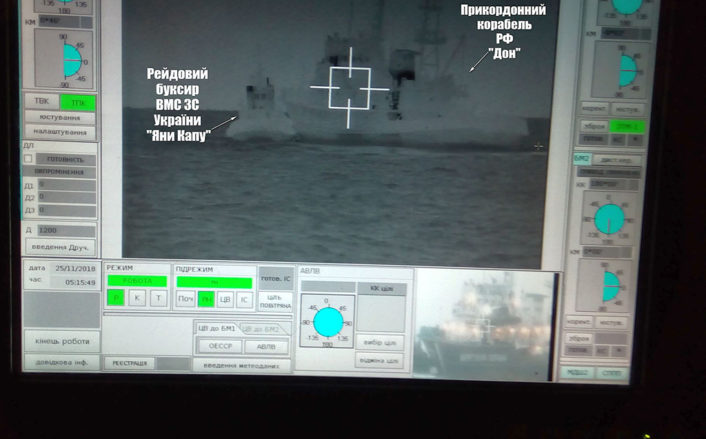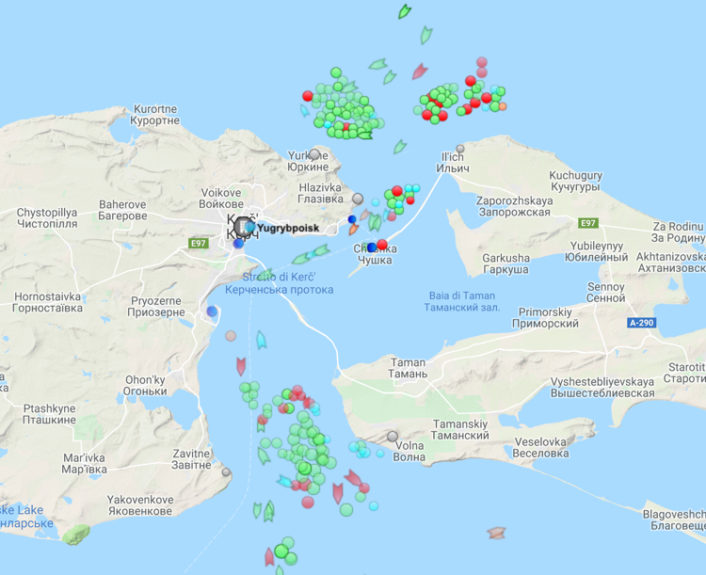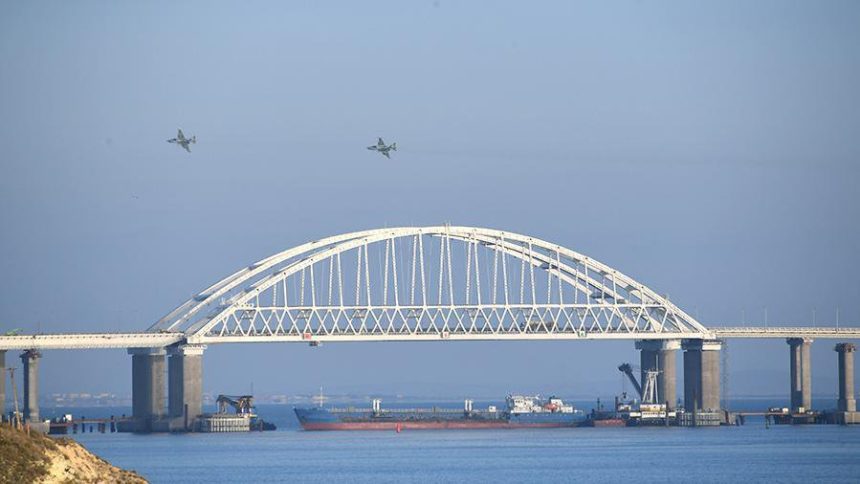Moscow has blocked passage through the Kerch Strait, between Crimea and mainland Russia, after three Ukrainian navy ships made what the Russian authorities have called a violation of Russian territorial waters.
Russia has stopped all navigation through the Kerch Strait, the only passage into the Sea of Azov amid growing tensions with Ukraine. Videos coming from the scene show a cargo ship, accompanied by two Russian military boats blocking the passage under the arch of the Kerch Bridge, which connects Crimea to Russia.
The blockade started at around 12.00LT on Sunday Nov. 25, 2018.
According to the Russians, the Kerch Strait was closed because three Ukrainian vessels sailed through the Russian territorial waters without authorization.
This version is denied by the Ukrainian side: “Russian coast guard vessels … carried out openly aggressive actions against Ukrainian navy ships” during the transit, a Ukrainian Navy statement said. The statement added that Russian authorities had been informed in advance about the planned transit, involving a Ukrainian navy tugboat, along with two Ukrainian Navy artillery boats,moving from Odessa on the Black Sea, to Mariupol, in the Sea of Azov.
The Ukrainian navy claimed a Russian coast guard vessel rammed the Ukrainian tugboat damaging the ship’s engine, hull, side railing and a lifeboat.
Here’s the image proving the “contact” between the Russian Border ship “Don” (on the right) and the Ukrainian tug “Jani Kapu”, released by the Ukrainian Navy:

Here’s the footage of the collision:
The moment of the collision of the 🇺🇦#Ukrainian and 🇷🇺#Russian ships. pic.twitter.com/BI5WQEFEII
— Capt(N) (@Capt_Navy) November 25, 2018
At 16.50LT, the Ukrainian Navy issued a legal commentary on the situation:
In accordance with Articles 17, 38 of the United Nations Convention on the Law of the Sea (hereinafter referred to as the UN Convention) and Article 2 of the Treaty between Ukraine and the Russian Federation on cooperation in the use of the Azov Sea and the Kerch Strait (hereinafter referred to as the Treaty), Ukrainian warships enjoy freedom of navigation in the Kerch Strait and the Sea of Azov, and therefore can pass through the Kerch Strait at any time, subject to the safety of navigation.
For reference. Article 17 of the UN Convention provides that, subject to compliance with the Convention, vessels of all states, both coastal and landlocked, enjoy the right to peaceful passage through the territorial sea.
Part 1, Article 36 of the UN Convention states that in the straits referred to in Article 37 of the UN Convention, all ships and aircraft shall enjoy the right of transit passage which shall not be obstructed.
Part 1 of Article 2 of the Treaty provides that merchant ships and warships, as well as other state-owned vessels under the flag of Ukraine or the Russian Federation, operated for non-commercial purposes, use the freedom of navigation in the Sea of Azov and the Kerch Strait.
Also, it should be noted that the trane of the boundary vessel of the Russian raiding tugs “Yana Kapu” falls under the signs of an act of aggression in accordance with the definition of Article 3, paragraph d), of Resolution No. 3314 (XXIX) of the General Assembly of the United Nations of December 14, 1974, namely: act aggression is, in particular, an attack by the armed forces of the state on land, naval or air forces, or naval and air fleets of another state.
On the other side, Russia’s Federal Security Service, known as the FSB, said that the Ukrainian ships violated Russian territorial waters, which were temporarily closed. The FSB accused the Ukrainian navy of staging a provocation against Russia:
“Today at 11.30 [08:30 GMT] the border guard service of Russia’s FSB registered the advancement of two Gurza-class artillery armored boats from the port of Berdyansk. At the moment, they are heading at full speed in the direction of the Kerch Strait to the zone where provocation was organized by the Ukrainian side. The border guard service of the Russian Federal Security Service takes all necessary measures to stop this provocation.”
A 2003 treaty designates the Kerch Strait and Sea of Azov as shared territorial waters between Russia and Ukraine. However, Russia has been asserting greater control over the passage since 2015.
Noteworthy, the Russians enforced the blockade dispatching also Su-25 Frogfoot attack planes, which were spotted overflying the bridge area several times.
2 Rssian Su-25 with anti ships missiles are now flying over kerch strait! https://t.co/d5OxeF2KKC
— Intel_Radar (@intel_radar24) November 25, 2018
Here’s another video:
Video of Su-25 aircrafts over Kerch bridge https://t.co/MQQjeOquTH pic.twitter.com/6SEyDYOxEc via @Defence_blog #Ukraine
— Liveuamap (@Liveuamap) November 25, 2018
Ka-52 were also filmed and photographed patrolling the area. The attack helicopters were in long-range configuration, carrying 575-lt drop tanks and what look like ATGMs and rocket launchers:
Can someone ID the payloads of the Ka-52 Russians send into the Kerch strait skirmish zone? I get it has 2 torpedoes plus the change.https://t.co/xW592em9ed pic.twitter.com/AyAzTOH1Sw
— lennutrajektoor (@lennutrajektoor) November 25, 2018
At the time of writing, dozens of cargo ships are stuck, awaiting for the passage to be reopened, based on AIS (Automatic Identification System), an automatic tracking system used by ships and Vessel Traffic Services (VTS) for identification and geo-localization of vessels, by mutually exchanging data with other ships and AIS Base stations.
The AIS is the naval homologous of the ADS-B used by airplanes and it is used for collision avoidance, search and rescue, accident investigation and for aids to navigation. It is mainly used by commercial vessels even if some military ships transmit AIS data.

Update Nov. 25, 18.30GMT
Ukrainian Navy says Russia opened fire on and seized the three of its vessels involved in the incident near the Kerch Strait. As a consequence, all Ukrainian Navy petsonnel was put in alert state, with all ships set at sea.
2 Ukrainian sailors are reportedly wounded. According to information collected, “Berdyansk” and “Nikopol” small armored artillery boats were damaged by enemy fire and are dead in the water. “Yany Kapu” tug was also halted. All ships are detained by RU SF teams.
— Ukrainian Military Portal (@mil_in_ua_en) November 25, 2018
Later, the Ukrainian MOD website could not be reached.
Looks like the Ukrainian MoD website is down at the moment. Increased traffic or cyberattack? pic.twitter.com/cFA0Q0tqFX
— David Cenciotti (@cencio4) November 25, 2018
The Ukrainian MOD website is once again reachable at 20:20GMT.
Here’s the transcript of the radio comms between the Russian border guard ships and the Ukrainian naval vessels fired upon in the Azov Sea:
So, here’s the transcript of the radio comms between the Russian border guard ships and Ukrainian naval vessels after firing in the Azov Sea. https://t.co/tyi57rujEg
— David Cenciotti (@cencio4) November 25, 2018









